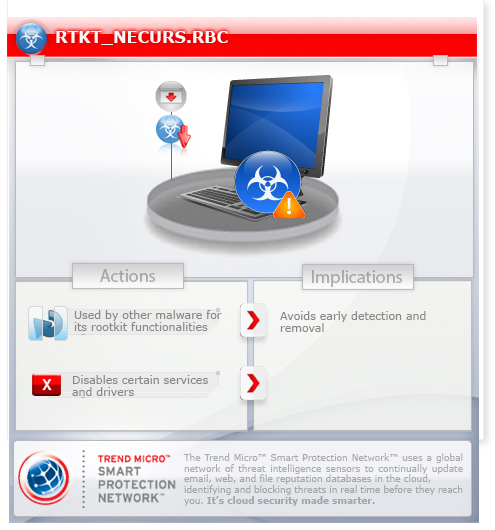RTKT_NECURS.RBC
Windows 2000, Windows Server 2003, Windows XP (32-bit, 64-bit), Windows Vista (32-bit, 64-bit), Windows 7 (32-bit, 64-bit)


Threat Type: Trojan
Destructiveness: No
Encrypted: Yes
In the wild: Yes
OVERVIEW
This malware is downloaded by TSPY_ZBOT.YYKE, a malware related to the new UPATRE variant that uses the 'spam within the spam' technique.
To get a one-glance comprehensive view of the behavior of this Trojan, refer to the Threat Diagram shown below.

This Trojan arrives on a system as a file dropped by other malware or as a file downloaded unknowingly by users when visiting malicious sites. It may be dropped by other malware.
It deletes the initially executed copy of itself.
TECHNICAL DETAILS
Arrival Details
This Trojan arrives on a system as a file dropped by other malware or as a file downloaded unknowingly by users when visiting malicious sites.
It may be dropped by the following malware:
- TSPY_ZBOT.YYKE
Installation
This Trojan drops the following copies of itself into the affected system:
- %System%\drivers\{random}.sys
(Note: %System% is the Windows system folder, which is usually C:\Windows\System32.)
Autostart Technique
This Trojan registers itself as a system service to ensure its automatic execution at every system startup by adding the following registry entries:
HKEY_LOCAL_MACHINE\SYSTEM\CurrentControlSet\
Services\{random}
DisplayName = "{random}"
HKEY_LOCAL_MACHINE\SYSTEM\CurrentControlSet\
Services\{random}
ErrorControl = "0"
HKEY_LOCAL_MACHINE\SYSTEM\CurrentControlSet\
Services\{random}
Group = "Boot Bus Extender"
HKEY_LOCAL_MACHINE\SYSTEM\CurrentControlSet\
Services\{random}
ImagePath = "%System%\drivers\{random}.sys"
HKEY_LOCAL_MACHINE\SYSTEM\CurrentControlSet\
Services\{random}
Start = "0"
HKEY_LOCAL_MACHINE\SYSTEM\CurrentControlSet\
Services\{random}
Tag = "1"
HKEY_LOCAL_MACHINE\SYSTEM\CurrentControlSet\
Services\{random}
Type = "1"
It registers as a system service to ensure its automatic execution at every system startup by adding the following registry keys:
HKEY_LOCAL_MACHINE\SYSTEM\CurrentControlSet\
Services\{random}
Rootkit Capabilities
This Trojan is used by other malware for its rootkit functionalities.
Other Details
This Trojan deletes the initially executed copy of itself
NOTES:
This Trojan disables services used by the following companies by modifying its code to return to unsuccessful status:
- ALWIL Software
- Agnitum Ltd
- Anti-Virus
- Avira GmbH
- BITDEFENDER LLC
- Beijing Jiangmin
- Beijing Rising
- BitDefender SRL
- BullGuard Ltd
- CJSC Returnil Software
- Check Point Software Technologies Ltd
- Comodo Inc
- Comodo Inc
- Comodo Security Solutions
- Doctor Web Ltd
- ESET, spol. s r.o.
- FRISK Software International Ltd
- G DATA Software
- GRISOFT, s.r.o.
- Immunet Corporation
- K7 Computing
- KProcessHacker
- Kaspersky Lab
- NovaShield Inc
- PC Tools
- Panda Software International
- Quick Heal Technologies
- SUNBELT SOFTWARE
- Sophos Plc
- Sunbelt Software
- VirusBuster Ltd
- WinDefend
- antimalware
This Trojan disables drivers with the following names by modifying its code to return to unsuccessful status:
- ATamptNt.sys
- AVC3.SYS
- AVCKF.SYS
- AhnRec2k.sys
- AhnRghLh.sys
- AntiLeakFilter.sys
- AntiyFW.sys
- ArfMonNt.sys
- AshAvScan.sys
- AszFltNt.sys
- BdFileSpy.sys
- EstRkmon.sys
- EstRkr.sys
- HookCentre.sys
- HookSys.sys
- K7Sentry.sys
- KmxAMRT.sys
- KmxAMVet.sys
- KmxAgent.sys
- KmxStart.sys
- MaxProtector.sys
- MiniIcpt.sys
- NanoAVMF.sys
- NovaShield.sys
- NxFsMon.sys
- OADevice.sys
- OMFltLh.sys
- PCTCore.sys
- PCTCore64.sys
- PLGFltr.sys
- PSINFILE.SYS
- PSINPROC.SYS
- PZDrvXP.sys
- PktIcpt.sys
- Rtw.sys
- SCFltr.sys
- SDActMon.sys
- SMDrvNt.sys
- SRTSP.sys
- SRTSP64.SYS
- SRTSPIT.sys
- STKrnl64.sys
- SegF.sys
- Spiderg3.sys
- THFilter.sys
- UFDFilter.sys
- V3Flt2k.sys
- V3Flu2k.sys
- V3Ift2k.sys
- V3IftmNt.sys
- V3MifiNt.sys
- Vba32dNT.sys
- ZxFsFilt.sys
- a2acc.sys
- a2acc64.sys
- a2gffi64.sys
- a2gffx64.sys
- a2gffx86.sys
- ahnflt2k.sys
- amfsm.sys
- amm6460.sys
- amm8660.sys
- antispyfilter.sys
- aswmonflt.sys
- avgmfi64.sys
- avgmfrs.sys
- avgmfx64.sys
- avgmfx86.sys
- avgntflt.sys
- avmf.sys
- bdfm.sys
- bdfsfltr.sys
- caavFltr.sys
- catflt.sys
- cmdguard.sys
- csaav.sys
- cwdriver.sys
- dkprocesshacker.sys
- drivesentryfilterdriver2lite.sys
- dwprot.sys
- eamonm.sys
- eeCtrl.sys
- eeyehv.sys
- eeyehv64.sys
- eraser.sys
- fildds.sys
- fortimon2.sys
- fortirmon.sys
- fortishield.sys
- fpav_rtp.sys
- fsfilter.sys
- fsgk.sys
- ggc.sys
- ikfilesec.sys
- ino_fltr.sys
- issfltr.sys
- issregistry.sys
- klbg.sys
- kldback.sys
- kldlinf.sys
- kldtool.sys
- klif.sys
- kmkuflt.sys
- lbd.sys
- mbam.sys
- mfehidk.sys
- mfencoas.sys
- mpFilter.sys
- nprosec.sys
- nregsec.sys
- nvcmflt.sys
- pervac.sys
- pwipf6.sys
- rvsmon.sys
- sascan.sys
- savant.sys
- savonaccess.sys
- shldflt.sys
- snscore.sys
- ssfmonm.sys
- ssvhook.sys
- strapvista.sys
- strapvista64.sys
- tkfsavxp.sys
- tkfsavxp64.sys
- tkfsft.sys
- tkfsft64.sys
- tmevtmgr.sys
- tmpreflt.sys
- v3engine.sys
- vcMFilter.sys
- vcdriv.sys
- vchle.sys
- vcreg.sys
- vradfil2.sys
SOLUTION
Step 1
Before doing any scans, Windows XP, Windows Vista, and Windows 7 users must disable System Restore to allow full scanning of their computers.
Step 3
Scan your computer with your Trend Micro product and note files detected as RTKT_NECURS.RBC
Step 4
Restart in Safe Mode
Step 5
Delete this registry key
Important: Editing the Windows Registry incorrectly can lead to irreversible system malfunction. Please do this step only if you know how or you can ask assistance from your system administrator. Else, check this Microsoft article first before modifying your computer's registry.
- In HKEY_LOCAL_MACHINE\SYSTEM\CurrentControlSet\Services
- {random}
- {random}
Step 6
Search and delete files detected as RTKT_NECURS.RBC
Step 7
Restart in normal mode and scan your computer with your Trend Micro product for files detected as RTKT_NECURS.RBC. If the detected files have already been cleaned, deleted, or quarantined by your Trend Micro product, no further step is required. You may opt to simply delete the quarantined files. Please check this Knowledge Base page for more information.
Did this description help? Tell us how we did.


